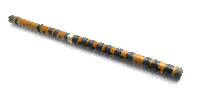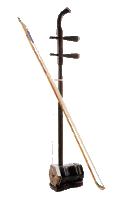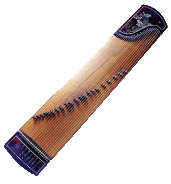 |
TRADITIONAL CHINESE INSTRUMENTS 中国民族乐器 |
 |
 Dizi: a transverse flute widely used in many genres of Chinese folk music, Chinese opera, and the modern Chinese orchestra. Traditionally, the dizi has also been popular among the Chinese common people as it is simple to make and easy to carry.
笛子: 是一种横向持握和吹奏的古老乐器,广泛地应用于演奏许多种中国的民间音乐、戏曲以及现代中国民族管弦乐。几千年来,笛子因为其简易的制作方法和轻便可携在中国民间广受欢迎。 |
 Huqin: an instrument family that consists of two-stringed bowed instruments used by various ethnic groups of China.
胡琴: 准确地说是一个包含了多种由两根弦组成并持弓演奏的乐器家族,并且可以在中国多个民族的历史长河中找寻到其悠远的足迹。
|
 The pipa (Chinese lute), is a four-stringed Chinese musical instrument which has a pear-shaped wooden body and belongs to the plucking family. Pipa first appeared in the Qin Dynasty (221-206 BCE) and was developed during the Han Dynasty. It is one of the most popular Chinese instruments and has been played for nearly 2000 years in China. The name “Pipa” is made up of two Chinese syllables (“pi” and “pa”) which are the two most common ways of playing this instrument. “Pi” is to push the fingers of the right hand from right to left, thus more than one finger can be used at a time striking multiple notes, and “pa” is to pull the thumb of the right hand from left to right, in the opposite direction.
琵琶: (中国的鲁特琴)是一种有四根弦的中国民族乐器。其外形酷似梨,且通身由木材打造,属于弹拨乐器家族。琵琶最早出现于公元前两百多年的秦代并在汉朝时期得到了长足的发展。琵琶是最受欢迎的中国民族乐器之一,并且已经具有了两千多年的历史。“琵”和“琶”二字实际上代表着演奏这种乐器最基本的两种方式。“琵”代表用右手的手指从右往左弹弦,从而能够在同一时间使用多根手指击出不同音调;“琶”意指用右手拇指从左向右的拨弦。一弹一拨之间,美妙的音乐由此产生。 |
 Zheng (guzheng): a plucked zither with 18–23 or more strings and movable bridges. The zheng rests on two pedestals and is played using 3 to 4 imitation fingernails. On the right side of the bridges, both hands pluck the strings and on the left side, the left fingers bend the strings to change pitch or to provide embellishment. Different techniques of playing the guzheng can create sounds that can evoke the sense of a cascading waterfall, thunder, horses' hooves or the scenic countryside.
筝(古筝): 是一种类似于扁琴或齐特琴的中国传统乐器,由18到23根弦组成,并有可以用于调音使用的琴码。 |